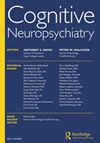Editorial: new directions in hallucination research
IF 0.9
4区 医学
Q3 PSYCHIATRY
引用次数: 0
Abstract
Hallucinations are deeply intriguing phenomena but conducting research on them can be challenging. Ineffable experiences can test the limits of traditional research methods and can rely on individuals sharing deeply personal and sometimes deeply distressing experiences. In addition, research is now moving beyond the established psychiatric paradigm of “voices and visions as symptoms” to examine how alterations to experience across the range of human experience can inform models of perception, meaning and memory. This special issue of Cognitive Neuropsychiatry is focused on new directions in hallucination research – and who better to expand the horizons of hallucinations research than early career researchers with the vision and foresight to tackle this area anew. The articles in this special issue comprise nine papers from the early career network of the International Consortium on Hallucination Research. Each of these papers has been led by a working group of early career researchers – often attracting more established and senior researchers as the work gathered momentum. The papers are an exciting collection of new visions for hallucinations research. The special issue begins with research on groups who have intense hallucinatory experiences but have rarely been the focus of systematic research. Palmer-Cooper and colleagues (Palmer-Cooper et al., 2021) examine the role of metacognition in two groups of people. Firstly, in people with ASMR (Autonomous Sensory Meridian Response) – a perceptual condition in which low-level audio-visual stimuli triggers intense somatic sensations in the head and neck regions that can spread throughout the body; and second in Tulpamancers individuals who, through self-training, develop the experience of seemingly autonomous identities existing in their consciousness. The study found a complex relationship between these experiences and measures of meta-cognition that did not simply mirror what is typically found in studies on patients with psychosis, suggesting that these experiences are unlikely to be simply “mild” experiences on the clinical spectrum. The paper by Montagnese and colleagues (Montagnese et al., 2021) examines types of hallucinations that are well-known clinically but are drastically under-researched – namely, hallucinations associated with neurodegenerative disorders and eye disease. One long-standing puzzle has been why hallucinations in these conditions relate so variably to insight, with some hallucinations associated with eye disease being visually spectacular but often clearly recognised as hallucinations. Montagnese and colleagues examined correlates of insight and found that it was predicted by better cognition and lower levels of distress, potentially suggesting a commonality with hallucinations in other domains, although the exact relationships varied across clinical conditions. Four studies focused on hallucinated voices, although took markedly different approaches. Using a simulation study, Bortolon and colleagues (Bortolon et al., 2021) found that both neutral and negative simulated voices triggered similar levels of subjective shame in volunteers, suggesting that the emotional impact of voices may be partly down to their intrusive社论:幻觉研究的新方向
幻觉是一种非常有趣的现象,但对它们进行研究可能具有挑战性。难以言喻的经历可以测试传统研究方法的局限性,并且可以依靠个人分享深刻的个人经历,有时甚至是非常痛苦的经历。此外,研究现在正在超越“声音和视觉作为症状”的既定精神病学范式,以研究人类经验范围内的经验变化如何影响感知、意义和记忆模型。本期《认知神经精神病学》特刊聚焦于幻觉研究的新方向——谁能比具有远见卓识的早期职业研究者更好地拓展幻觉研究的视野呢?本期特刊的文章包括来自国际幻觉研究协会早期职业网络的九篇论文。这些论文中的每一篇都是由一个由早期职业研究人员组成的工作组领导的——随着工作的发展,往往会吸引更多的资深研究人员。这些论文为幻觉研究提供了令人兴奋的新视野。这期特刊从对有强烈幻觉经历但很少成为系统研究焦点的群体的研究开始。Palmer-Cooper及其同事(Palmer-Cooper et al., 2021)研究了元认知在两组人群中的作用。首先,在ASMR(自主感觉经络反应)患者中,这是一种感知状态,低水平的视听刺激会在头部和颈部区域引发强烈的躯体感觉,这种感觉会扩散到全身;第二种是图尔帕曼人,他们通过自我训练,发展出存在于他们意识中的看似自主的身份体验。研究发现,这些经历与元认知测量之间存在复杂的关系,而这种关系并不简单地反映了在精神病患者研究中发现的典型情况,这表明这些经历不太可能是临床谱上简单的“轻度”经历。Montagnese及其同事的论文(Montagnese et al., 2021)检查了临床上众所周知但研究严重不足的幻觉类型-即与神经退行性疾病和眼病相关的幻觉。一个长期存在的谜团是,为什么这些情况下的幻觉与洞察力的关系如此不同,一些与眼病相关的幻觉在视觉上很壮观,但通常被清楚地识别为幻觉。Montagnese及其同事研究了洞察力的相关性,发现它可以通过更好的认知和更低的痛苦水平来预测,这可能表明它与其他领域的幻觉有共同之处,尽管确切的关系因临床条件而异。四项研究聚焦于幻听,尽管采用了明显不同的方法。通过一项模拟研究,Bortolon及其同事(Bortolon et al., 2021)发现,中性和消极的模拟声音在志愿者中引发的主观羞耻感水平相似,这表明声音的情绪影响可能部分归因于它们的侵入性
本文章由计算机程序翻译,如有差异,请以英文原文为准。
求助全文
约1分钟内获得全文
求助全文
来源期刊

Cognitive Neuropsychiatry
PSYCHIATRY-
CiteScore
3.20
自引率
11.80%
发文量
18
审稿时长
>12 weeks
期刊介绍:
Cognitive Neuropsychiatry (CNP) publishes high quality empirical and theoretical papers in the multi-disciplinary field of cognitive neuropsychiatry. Specifically the journal promotes the study of cognitive processes underlying psychological and behavioural abnormalities, including psychotic symptoms, with and without organic brain disease. Since 1996, CNP has published original papers, short reports, case studies and theoretical and empirical reviews in fields of clinical and cognitive neuropsychiatry, which have a bearing on the understanding of normal cognitive processes. Relevant research from cognitive neuroscience, cognitive neuropsychology and clinical populations will also be considered.
There are no page charges and we are able to offer free color printing where color is necessary.
 求助内容:
求助内容: 应助结果提醒方式:
应助结果提醒方式:


